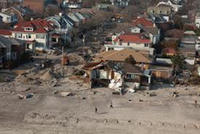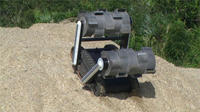-
Salt Lake Community College to offer homeland security program
According to statistics from the U.S. Department of Labor, the need for emergency management professionals, protective service workers, and police and sheriff’s patrol officers is likely to increase more than 33 percent between 2011 and 2018. The Utah Board of Regents has approved the first Homeland Security and Emergency Management associate of applied degree in the state at Salt Lake Community College (SLCC).
-
-
New internally cured concrete increases bridge life span
Concrete is normally made by mixing portland cement with water, sand, and stone. In the curing or hardening process, water helps the concrete mixture gain strength by reacting with the cement. Traditionally, curing is promoted by adding water on top of the bridge deck surface. The new technology for internal curing provides additional water pockets inside the concrete, enhancing the reaction between the cement and water, which adds to strength and durability. This new technology is enabling Indiana to improve bridges in the state with a new “internally cured” high-performance concrete.
-
-
2013 Summer Programs for Science Teachers open for applications
The National Institute of Standards and Technology (NIST) is accepting applications for the 2013 NIST Summer Institute for Middle School Science Teachers and the Research Experience for Teachers programs. Both programs offer educators the chance to interact with and learn from top scientists and engineers, in classroom and laboratory settings. The application deadline is 20 March 2013.
-
-
NY to buy, demolish beachfront homes, make way for storm buffers

New York governor Andrew Cuomo plans to use $400 million in federal funding to buy beachfront homes as part of a broader plan to reshape the New York coastline so the state is better prepared for sea level rise, surges, and storms. The plan is to raze the purchased homes and leave to shore front vacant. Some properties would be turned into dunes, wetlands, or other natural buffers. Other parcels could be combined and turned into public parkland.
-
-
New clean coal technology provides energy without burning
A new form of clean coal technology reached an important milestone recently, with the successful operation of a research-scale combustion system. The technology is now ready for testing at a larger scale. For 203 continuous hours, the combustion unit produced heat from coal while capturing 99 percent of the carbon dioxide produced in the reaction.
-
-
The humble sea urchin may hold the key to carbon capture
Each year, humans emit on average 33.4 billion metric tons of CO2 — around 45 percent of which remains in the atmosphere. At present, pilot studies for Carbon Capture and Storage (CCS) systems propose the removal of CO2 by pumping it into holes deep underground. This is a costly and difficult process, and it carries with it a long term risk of the gas leaking back out — possibly many miles away from the original downward source. An alternative solution is to convert the CO2 into calcium or magnesium carbonate.
-
-
Novel nanosized antenna arrays key to effective harvesting of solar energy
For years, scientists have studied the potential benefits of a new branch of solar energy technology that relies on incredibly small nanosized antenna arrays that are theoretically capable of harvesting more than 70 percent of the sun’s electromagnetic radiation and simultaneously converting it into usable electric power. A novel fabrication technique could provide the breakthrough technology scientists have been looking for to improve today’s solar energy systems.
-
-
Wastewater from fracking is often highly radioactive
New studies have found that waste from fracking operations can be highly radioactive. A geological survey reported that millions of barrels of wastewater from unconventional wells in Pennsylvania and conventional wells in New York are 3,609 times more radioactive than the federal limit for drinking water, and 300 times more radioactive than a Nuclear Regulatory Commission limit for nuclear plant discharges.
-
-
Climate change threatens public health, safety, economy along U.S. coasts
A new technical study from the U.S. National Oceanic and Atmospheric Agency (NOAA) and the U.S. Geological Survey (USGS) reports that the effects of climate change will continue to threaten the health and vitality of U.S. coastal communities’ social, economic, and natural systems. All U.S. coasts are highly vulnerable to the effects of climate change such as sea-level rise, erosion, storms, and flooding, especially in the more populated low-lying parts of the U.S. coast along the Gulf of Mexico, Mid-Atlantic, northern Alaska, Hawaii, and island territories. The report says that the financial risks associated with both private and public hazard insurance are expected to increase dramatically.
-
-
New bridge construction technologies to shore up U.S. infrastructure
Experts agree that there is an urgent need to construct and repair bridges across the United States. Around 70,000 bridges in the country are considered “structurally deficient” by government standards. New technology could help the United States manage its growing, and aging, infrastructure without breaking the bank or levying high taxes on citizens.
-
-
NASA engineers building sturdy blue-collar mining robot

After decades of designing and operating robots full of scientific gear to study other worlds, NASA is working on a prototype that leaves the delicate instruments at home in exchange for a sturdy pair of diggers and the reliability and strength to work all day, every day for years.
-
-
Extreme rainfall linked to global warming
A worldwide review of global rainfall data has found that the intensity of the most extreme rainfall events is increasing across the globe as temperatures rise. In the most comprehensive review of changes to extreme rainfall ever undertaken, researchers evaluated the association between extreme rainfall and atmospheric temperatures at more than 8,000 weather gauging stations around the world.
-
-
Why some immigrants get citizenship

For immigrants, the path to citizenship in many countries is filled with hurdles: finding a job, learning the language, passing exams. For some people, however, the biggest obstacle of all may be one they cannot help: their country of origin.
-
-
Conflicting cultural identities foster political radicalism
New research suggests that dual-identity immigrants — first-generation immigrants and their descendants who identify with both their cultural minority group and the society they now live in — may be more prone to political radicalism if they perceive their two cultural identities to be incompatible.
-
-
The historical probability of drought

Droughts can severely limit crop growth, causing yearly losses of around $8 billion in the United States. It may be possible, however, to minimize those losses if farmers can synchronize the growth of crops with periods of time when drought is less likely to occur. Researchers are working to create a reliable “calendar” of seasonal drought patterns that could help farmers optimize crop production by avoiding days prone to drought.
-
More headlines
The long view
A Shining Star in a Contentious Legacy: Could Marty Makary Be the Saving Grace of a Divisive Presidency?
While much of the Trump administration has sparked controversy, the FDA’s consumer-first reforms may be remembered as its brightest legacy. From AI-driven drug reviews to bans on artificial dyes, the FDA’s agenda resonates with the public in ways few Trump-era policies have.
Risk Assessment with Machine Learning
Researchers utilize geological survey data and machine learning algorithms for accurately predicting liquefaction risk in earthquake-prone areas.
Foundation for U.S. Breakthroughs Feels Shakier to Researchers
With each dollar of its grants, the National Institutes of Health —the world’s largest funder of biomedical research —generates, on average, $2.56 worth of economic activity across all 50 states. NIH grants also support more than 400,000 U.S. jobs, and have been a central force in establishing the country’s dominance in medical research. Waves of funding cuts and grant terminations under the second Trump administration are a threat to the U.S. status as driver of scientific progress, and to the nation’s economy.
The True Cost of Abandoning Science
“We now face a choice: to remain at the vanguard of scientific inquiry through sound investment, or to cede our leadership and watch others answer the big questions that have confounded humanity for millennia —and reap the rewards.”
Bookshelf: Smartphones Shape War in Hyperconnected World
The smartphone is helping to shape the conduct and representation of contemporary war. A new book argues that as an operative device, the smartphone is now “being used as a central weapon of war.”
New Approach Detects Adversarial Attacks in Multimodal AI Systems
New vulnerabilities have emerged with the rapid advancement and adoption of multimodal foundational AI models, significantly expanding the potential for cybersecurity attacks. Topological signatures key to revealing attacks, identifying origins of threats.
